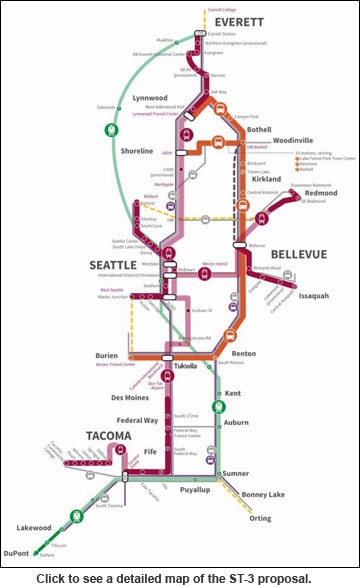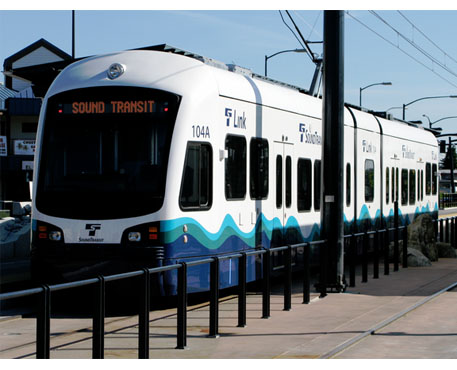OPINION
It’s time to invest in Sound Transit Phase 3—and our future
By JEFF JOHNSON
(July 5, 2016) — Seattle traffic is the sixth worst in the country. The average driver loses 66 hours of his or her life each year due to gridlock. To put this in perspective, one day while parked on I-5, I figured out that 66 hours was the equivalent of reading War and Peace cover-to-cover (all 1,200-plus pages), playing two rounds of golf, enjoying two concerts, watching the Mariners play a double header, and rafting 20 miles on the Yakima River. For those of us unfortunate enough to drive more than the average driver, the list of things we could have done is much longer.
Relief is on the way as projects from the 2015 transportation package are undertaken and begin to relieve congestion. But relief from gridlock will get major help from the bold ST-3 plan announced by Sound Transit, to go before the voters of King, Snohomish and Pierce counties this November. Let’s take a look at what ST-3 offers.
 ST-3, Sound Transit Phase 3, will greatly expand mass transit in the Puget Sound region. It will add 62 miles of light rail, commuter rail, and bus rapid transit, to the existing Sound Transit System. Upon completion of ST-3, we will have 116 miles of light rail — about the size Washington, D.C.’s Metro System — extending from Tacoma in the South, West Seattle and Ballard to the West, Issaquah and Redmond to the East, and Everett to the North. This transit system will tie the Central Puget Sound region together with 75 transit stations and connecting 90% of jobs and residents of the Puget Sound to light rail.
ST-3, Sound Transit Phase 3, will greatly expand mass transit in the Puget Sound region. It will add 62 miles of light rail, commuter rail, and bus rapid transit, to the existing Sound Transit System. Upon completion of ST-3, we will have 116 miles of light rail — about the size Washington, D.C.’s Metro System — extending from Tacoma in the South, West Seattle and Ballard to the West, Issaquah and Redmond to the East, and Everett to the North. This transit system will tie the Central Puget Sound region together with 75 transit stations and connecting 90% of jobs and residents of the Puget Sound to light rail.
ST-3 will be a major source of economic development. This $54 billion infrastructure project will create about 50 million labor hours providing many tens of thousands of building and construction jobs and great opportunities for local hire and for new, young apprentices to join the trades. A few years into the project and ST-3 will account for over 1 in 10 construction jobs through both good and bad economic cycles. The wages from these jobs will be spent locally giving an economic boost to businesses in the region and bringing much needed tax revenue into state and local governments.
By extending the existing Project Labor Agreements, Transit Oriented Development policies and offering 80% of surplus property to affordable housing developers, ST-3 will maximize continuous development, local hire, and mixed-use and mixed-income affordable housing and small business development.
Expanding mass transit will reduce the number of cars on the roads, lower traffic congestion and significantly reduce carbon pollution and green house gasses. It is estimated that ST-3 will reduce vehicle miles traveled on our highways by 313 million miles by 2040. This means many thousands of fewer cars on the roads and an annual reduction of CO2 pollution of 125,000 metric tons per year. This is equivalent to 9% of our region’s greenhouse gas emissions. By itself, ST-3 will be a major contributor to reducing the negative effects of climate change.
 The price tag for ST-3 is about $54 billion dollars over 25 years. About $32 billion will be from local taxes, a combination of small increases in the MVET, local sales tax, and property tax. To put this in perspective it amounts to about $17 per month per person or about $200 per year. To place this in a bigger perspective, ST-3 is a major investment in cleaner air and water and less pollution, tens of thousands of direct and indirect jobs, affordable housing, connecting workers to jobs and people to appointments, and giving people back more time to enjoy with their families rather than being spent parked on the highways in gridlock.
The price tag for ST-3 is about $54 billion dollars over 25 years. About $32 billion will be from local taxes, a combination of small increases in the MVET, local sales tax, and property tax. To put this in perspective it amounts to about $17 per month per person or about $200 per year. To place this in a bigger perspective, ST-3 is a major investment in cleaner air and water and less pollution, tens of thousands of direct and indirect jobs, affordable housing, connecting workers to jobs and people to appointments, and giving people back more time to enjoy with their families rather than being spent parked on the highways in gridlock.
Some have argued that ST-3 is too big a project and that the cost will compete with the Legislature in its attempt to raise revenue to sufficiently fund our K-12 education system per the Supreme Court’s mandate in the McCleary decision. This argument is as wrong as it is short-sighted. It is, in fact, the Legislature’s inaction on raising revenue that has led to the underfunding of education, mental health, a whole range of other social services, as well as inadequate wages and benefits for public employees. The failure of our State Legislature has forced local and regional governments to move forward with a vision of what we need to do to create healthier and stronger communities and to use the existing revenue options that they have available to them to invest in a more prosperous Washington. If we all had to wait on the State Legislature to act, we would unfortunately get nowhere fast.
It is time to invest in our future. It is time to invest in ST-3.
 Jeff Johnson is President of the Washington State Labor Council, AFL-CIO, the largest labor organization in the Evergreen State, representing the interests of more than 600 local unions and approximately 450,000 rank-and-file union members.
Jeff Johnson is President of the Washington State Labor Council, AFL-CIO, the largest labor organization in the Evergreen State, representing the interests of more than 600 local unions and approximately 450,000 rank-and-file union members.





